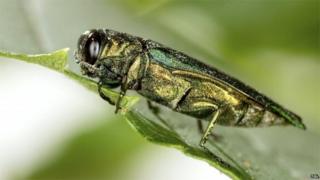 Picture copyright
Picture copyright
SPL
The exiguous emerald ash borer arrived within the US in 2002 and has since killed tens of 1000’s and 1000’s of ash bushes
For the primary time, a ogle has tried to evaluate the devastation precipitated by the emerald ash borer in US forests that form river methods.
Researchers realized a fluctuate of concepts that the ecologically elementary habitat is being systematically modified at a panorama degree.
Because it was realized within the US in 2002, the invasive bugs beget worn out tens of 1000’s and 1000’s of ash bushes.
The findings will seem within the journal Woodland Ecology and Administration.
Because it was first recorded in Michigan, the exiguous wood-dreary beetle has unfold proper by the north-japanese attain of the US, killing tens of 1000’s and 1000’s of ash bushes.
The label to the nation’s financial system has been estimated to exceed $10bn.
Then but once more, a staff from Michigan Notify School noticed that cramped consideration had been paid to how the invasion was altering the face of riparian (water/river system) forests.
Weak wetlands
“In North The USA, inexperienced and unhappy ash [trees] are two elementary species, ecologically talking,” outlined co-author Patrick Engelken from the school’s division of entomology.
“The wetland habitats are most steadily inundated ultimately of spring moist months. The tree species that develop there wish to be of route tolerant of getting heaps of water on their roots,” he added.
“And they also’re functionally linked to those waterways the place the nutrient current inside these breeze methods is straight mediated by these surrounding forests”
Picture copyright
SPL
Inexperienced and unhappy ash bushes dominate riparian forests in Michigan, nevertheless are weak to the invasive beetle
Mr Engelken additionally acknowledged that assorted parts beget been additionally regulated by these forests, equal to diet distribution, leaf litter depositions, temperature moderation and shading.
When the staff examined the affect of 15 years of the invasive emerald ash borer proper by forests in three watersheds, though there was well-liked mortality, the legacy on the ground assorted extensively.
“The bushes in south east Michigan had begun to of route decay and break down and secure,” Mr Engelken advised BBC Data.
“We beget been climbing over piles of listless ash bushes in begin cover areas that weak to be dense overstorey (the uppermost cover degree of a woodland, fashioned by the tallest bushes).
“And about 120 miles to the west, we’d peek the standing listless bushes. These beget been going to beget of route gigantic scale impacts on the surroundings; the riparian woodland ground and within the streams as neatly.
Ugly variations
The researchers additionally stumbled on a great deal of log jamming within the water system, which had the aptitude to alternate the system the river methods behaved ultimately of intervals of flooding.
Then but once more, they acknowledged that one of many assorted outcomes that they encountered weren’t what that they had primarily anticipated to peek.
“Ash bushes nonetheless stay extremely considerable within the sapling strata, within the understory. By a great distance, the dominant species – in cover gaps not not as a lot as – beget been species of ash, primarily inexperienced ash.
Mr Engelken outlined that this was perchance the ultimate consequence of emerald ash borer densities being nice decrease than they beget been ultimately of the invasion’s top. This was primarily a outcomes of the bugs’ meals supply, historical ash bushes, being long gone.
“Now we have bought this wholesome cohort of ash within the understory (a layer of vegetation beneath the woodland’s predominant cover) the place if the (ash borer) stress stays low on them, you presumably can begin as a lot as peek some ash begin as a lot as uncover increased and begin to produce a recent overstorey of ash within the impending years,” he acknowledged.
One different factor that very a lot shocked the researchers was the dense practice of herbaceous (non-woody) flora within the areas the place the duvet had long gone.
“We had anticipated to peek invasive plant species switch in and dominate,” Mr Engelken outlined.
“Nevertheless what we noticed in almost every single set was that the understorey is totally coated in dense herbaceous hundreds. Sedges that not easiest gave the affect to be outcompeting seedlings nevertheless invasive species as neatly.”
Mr Engelken warned that the conversion of those areas of habitat to start out sedge meadows from ash-dominated riparian forests can beget lasting outcomes as a great distance as offering shade or nutritional vitamins to watercourses.
He acknowledged that riparian forests had been overlooked or unnoticed when it bought proper right here to the outcomes of the emerald ash borer invasion.
Then but once more, he acknowledged that if policymakers positioned considerably further urgency on these elementary habitats then the legacy from the emerald ash borer will beget been nice decreased.
“Ash bushes are of route comely mass bushes; they set out a great deal of seeds and so they develop speedy or hardy,” he seen.
“It could excellent clutch considerably little bit of foresight to seize a study at to withhold some substantial, historical bushes to in all probability withhold these habitats.
“Restoration is superior. It’s nice further superior than obsessed with them beforehand. I’d insist excellent articulate these riparian corridors and the species occupying them, as they’re… of route elementary ecosystems.”
No comments:
Post a Comment